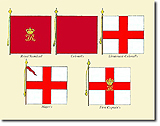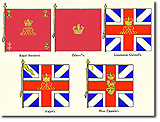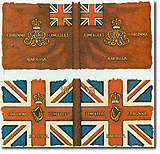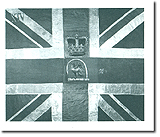|
|

In the early regiments, each company had it's own Colour. The Captain of each company put his device in the centre of the Colour. The Captains would be of any rank including the Colonel who commanded the senior company. In the 1st Guards, the senior company was the King's company who's Colour was plain crimson with the crown and cypher in the middle in gold. King Charles II presented Royal badges for each of the other companies. This did not happen in the other two Guards regiments until 1750. In time, the Company Colours were basically the Union Flag with the device in the middle and the company number in the 'canton' (upper corner nearest the pole or pike). By mid 19th century, there were 30 companies in all, their badges were as follows:
| 1st or King's/Queen's Company | The Royal Crest of England |
| 2nd | Red & white rose incorporated, seeded gold, barbed green |
| 3rd | Golden fleur-de-lys |
| 4th | Golden portcullis |
| 5th | White rose, seeded gold, barbed green within golden sun |
| 6th | Thistle |
| 7th | Golden harp with silver strings |
| 8th | Red dragon of Cadwallader on green mount |
| 9th | White greyhound on green mount, with gold collar |
| 10th | Golden sun with sunbeams and human face |
| 11th | Silver unicorn statant on green mount, with gold collar, chain, horn, mane & hoofs |
| 12th | Silver antelope statant with gold collar, chain, horns and hoofs on green mount |
| 13th | Kneeling White hart with gold crown,chain, horns etc on green mount |
| 14th | Silver falcon within gold fetterlock |
| 15th | Red rose of Lancaster |
| 16th | Silver swan with gold crown and chain on green mount |
| 17th | White falcon crowned, holding a sceptre, standing on the root of a tree between two branches of white and red roses |
| 18th | Root of a tree with branches sprouting |
| 19th | Sword and sceptre crossed |
| 20th | Royal oak with the head of King Charles II among branches |
| 21st | Sun rising out of clouds |
| 22nd | Burning beacon |
| 23rd | Two crossed ostrich feathers |
| 24th | Royal crest of Ireland |
| 25th | St George's cross on silver shield |
| 26th | A blue shield upon which is a rampant gold lion with ducal coronet. The shield is sprinkled with golden 'billets'. (Arms of Nassau) |
| 27th | Badge of the Order of the Bath |
| 28th | Crest of Brunswick or Hanover |
| 29th | Shamrock leaf |
| 30th | Crest of the Prince Consort |
| Size of Colours | |
| 1684 | 6ft 9in wide x 6ft 6in deep |
| 1747 | 6ft 6in wide x 6ft 2in deep |
| 1768 | 6ft 6in wide x 6ft deep |
| 1855 | 6ft wide x 5ft 6in deep |
| 1858 | 4ft 6in wide x 4ft deep |
| 1868 | 3ft 9in x 3ft deep |
 |
 |
|
| Colours, 1685 | Colours, 1745 | |
 |
||
| 2nd Battalion Colours, 1812 | ||
 |
 |
|
| Colours, 1751 | 14th Company Colour c1820 | |
 |
||
| 1st Battalion Colours c1870 |
Armed Forces | Art and Culture | Articles | Biographies | Colonies | Discussion | Glossary | Home | Library | Links | Map Room | Sources and Media | Science and Technology | Search | Student Zone | Timelines | TV & Film | Wargames